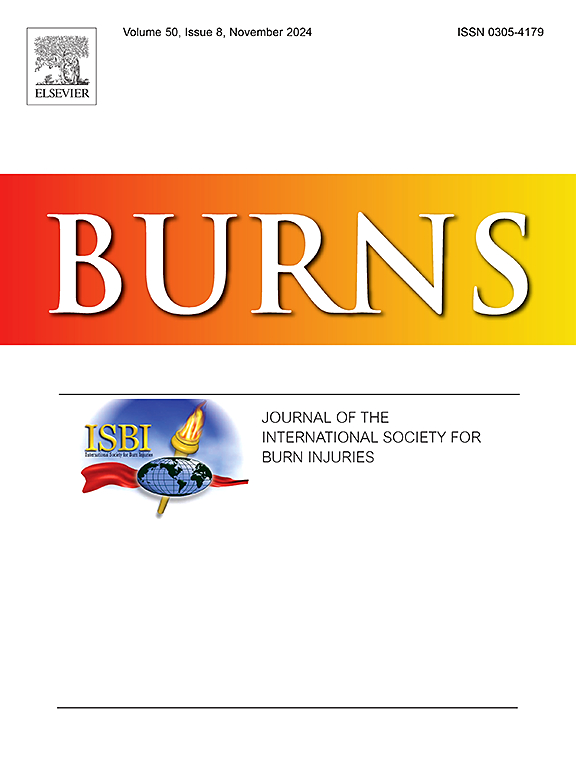Control of invasive Pseudomonas burn wound infection with mafenide acetate electrospun wound dressing
IF 2.9
3区 医学
Q2 CRITICAL CARE MEDICINE
引用次数: 0
Abstract
Invasive wound infections are a leading cause of mortality in burn patients. Pseudomonas aeruginosa is among the most prevalent organisms associated with invasive burn wound infections. It is most effectively prevented by Sulfamylon® cream. The active compound, mafenide acetate, enters the wound rapidly and achieves the local concentration of 2- to 5- fold above the minimal inhibitory concentration for P. aeruginosa at 1–2 hrs. However, within 8–10 hrs, the mafenide acetate concentration rapidly declines to subinhibitory concentrations, and the treatment needs to be reapplied. In this study, we described the development of an electrospun burn wound dressing that could sustain the treatment effect by continuously releasing mafenide acetate at therapeutic concentrations into burn wounds for ≥ 24 hrs. We demonstrated by scanning electron microscopy that the mafenide acetate electrospun wound dressing consisted of smooth and uniform fibers. The extent and rate of mafenide acetate release from the dressing were determined in vitro using drug release and skin permeation tests and in vivo using a rat burn model. Finally, the mafenide acetate electrospun wound dressing’s antimicrobial activity in vitro and its capability to control invasive Pseudomonas infection in vivo was determined using a modified AATCC 100 test and the modified Walker-Mason scalded rat burn model, respectively.
醋酸马夫尼特静电纺敷料控制侵袭性假单胞菌烧伤创面感染
创伤性感染是烧伤患者死亡的主要原因。铜绿假单胞菌是与侵袭性烧伤创面感染相关的最普遍的生物体之一。最有效的预防方法是使用Sulfamylon®霜。活性化合物醋酸马夫尼酯进入创面迅速,在1-2小时内达到铜绿假单胞菌最低抑菌浓度的2- 5倍。然而,在8-10小时内,醋酸马夫尼德浓度迅速下降到亚抑制浓度,需要重新施用。在这项研究中,我们描述了一种电纺烧伤创面敷料的发展,该敷料可以通过在烧伤创面连续释放治疗浓度的醋酸马菲尼德≥24小时来维持治疗效果。我们通过扫描电镜证明了醋酸马夫尼酯静电纺伤口敷料由光滑均匀的纤维组成。体外用药物释放和皮肤渗透试验测定敷料中醋酸马芬尼酯的释放程度和释放速度,体内用大鼠烧伤模型测定。最后,采用改良的AATCC 100试验和改良的Walker-Mason烫伤大鼠模型,分别测定醋酸马菲尼德静电纺创面敷料的体外抗菌活性和体内控制侵袭性假单胞菌感染的能力。
本文章由计算机程序翻译,如有差异,请以英文原文为准。
求助全文
约1分钟内获得全文
求助全文
来源期刊

Burns
医学-皮肤病学
CiteScore
4.50
自引率
18.50%
发文量
304
审稿时长
72 days
期刊介绍:
Burns aims to foster the exchange of information among all engaged in preventing and treating the effects of burns. The journal focuses on clinical, scientific and social aspects of these injuries and covers the prevention of the injury, the epidemiology of such injuries and all aspects of treatment including development of new techniques and technologies and verification of existing ones. Regular features include clinical and scientific papers, state of the art reviews and descriptions of burn-care in practice.
Topics covered by Burns include: the effects of smoke on man and animals, their tissues and cells; the responses to and treatment of patients and animals with chemical injuries to the skin; the biological and clinical effects of cold injuries; surgical techniques which are, or may be relevant to the treatment of burned patients during the acute or reconstructive phase following injury; well controlled laboratory studies of the effectiveness of anti-microbial agents on infection and new materials on scarring and healing; inflammatory responses to injury, effectiveness of related agents and other compounds used to modify the physiological and cellular responses to the injury; experimental studies of burns and the outcome of burn wound healing; regenerative medicine concerning the skin.
 求助内容:
求助内容: 应助结果提醒方式:
应助结果提醒方式:


